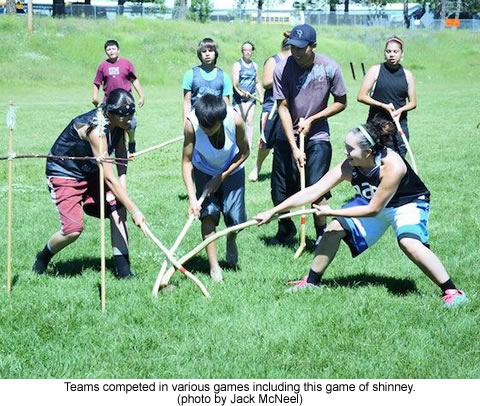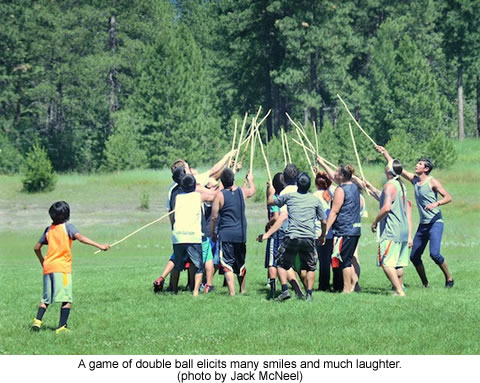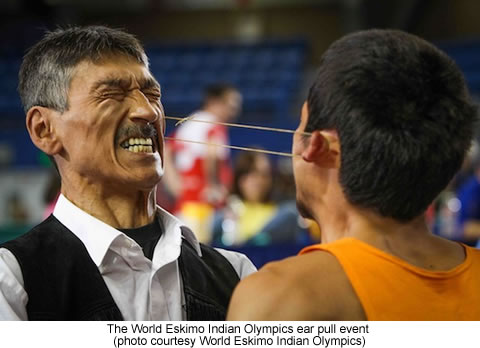 |
Canku Ota
|
 |
|
(Many Paths)
|
||
|
An Online Newsletter
Celebrating Native America
|
||
|
August 2013 - Volume
11 Number 8
|
||
|
|
||
|
Lacrosse, Shinney
& Double Ball:
How Games Can Beat Historical Trauma |
||
|
by Jack McNeel - Indian
Country Today Media Network
|
||
|
Gregory Cajete, Tewa from Santa Clara Pueblo and director of Native American Studies at the University of New Mexico, has authored five books dealing with Native games. "We see young children as they're growing up, especially the first few years of their life. Everything is play. The human propensity to be athletic is a very integral part of natural forms of education. It's also the way the brain develops." Jaak Panksepp, a neuroscientist at Washington State University, has studied games and their effect on the brain. "The most sophisticated emotion built into our brains is play," he said. "If we take play out of the lives of our children we will have children that cannot grow up to be normal, vibrant, positive human beings that respect others and know how to interact with them. Play is the bridge to a full human life." The third element, historical trauma, is well documented among Indigenous Peoples. Native Americans have been subjected to it in many ways, including the period of boarding schools that altered tribal life--and tribal games. "Early on Native games were targeted to erase them," Cajete said. "If you're trying to subjugate a people you begin to go for those institutions that bring people together and have an influence in terms of how well they can be controlled. Native games were the focus of many agents at that time."
Recovering and restoring those traditional games, getting them reintroduced in Native communities and in schools, is the goal of the International Traditional Games Society, hosts of the conference. Young people, teens and pre-teens, came to the conference to learn and to compete in various games. Jeremy Red Eagle, Sioux, is a board member of the International Traditional Games Society. He brought 10 young people with him from Helena, Montana. "We focus on the positive things: our language, our ceremonies and culture, our song and dance-and our games." Then Red Eagle commented on two weeks of traveling with these young people and how they were sticking together without fighting or arguments. "These games are the foundation of what started our youth program. These kids will be leaders in our communities." Many games are played on a field while many others can be played in a classroom or at home. Most are quite simple and can be played with materials readily available: rocks, limbs, sticks, balls of buckskin or yarn. The list goes on. Some are games of skill or endurance while others may be of intuition.
Nicole Johnston, Inupiaq, chairs the World Eskimo Indian Olympics. She brought two young athletes to the conference to demonstrate games played in the far north. She is also a record holder in the women's two-foot high kick. Their games are all designed for survival in the arctic north and thus very different from those which originated farther south. The youth who participated in the games were honored at the final ceremony. Gifts were distributed including sets for shinney and double ball The visitors from Alaska gave gifts of an Indian stick pull stick and a kick-ball to the host organization. |
|
|
||
|
|
||
| Canku Ota is a free Newsletter celebrating Native America, its traditions and accomplishments . We do not provide subscriber or visitor names to anyone. Some articles presented in Canku Ota may contain copyright material. We have received appropriate permissions for republishing any articles. Material appearing here is distributed without profit or monetary gain to those who have expressed an interest. This is in accordance with Title 17 U.S.C. Section 107. | ||
|
Canku Ota is a copyright ©
2000 - 2013 of Vicki Williams Barry and Paul Barry.
|
||
 |
 |
|
|
The "Canku
Ota - A Newsletter Celebrating Native America" web site and
its design is the
|
||
|
Copyright ©
1999 - 2013 of Paul C. Barry.
|
||
|
All Rights Reserved.
|
||
 Native
games, neuroscience, and historical trauma--they sound like an odd
trio but collectively may provide answers to problems across Indian
country. Educators, researchers, and youngsters from Alberta, Saskatchewan,
the western U.S. and Alaska, even as far away as Delhi, India gathered
at the First International Traditional Native Games Conference in
Pablo, Montana on June 26-28.
Native
games, neuroscience, and historical trauma--they sound like an odd
trio but collectively may provide answers to problems across Indian
country. Educators, researchers, and youngsters from Alberta, Saskatchewan,
the western U.S. and Alaska, even as far away as Delhi, India gathered
at the First International Traditional Native Games Conference in
Pablo, Montana on June 26-28. The
loss of games at boarding schools was illustrated when 17 elders
from the Blackfeet Nation were invited to watch as youngsters took
part in some games, and to offer comments as tribal protocol dictates.
In some cases the youngsters knew much more about the games than
did the elders, most of whom had spent time in boarding schools
during their early years.
The
loss of games at boarding schools was illustrated when 17 elders
from the Blackfeet Nation were invited to watch as youngsters took
part in some games, and to offer comments as tribal protocol dictates.
In some cases the youngsters knew much more about the games than
did the elders, most of whom had spent time in boarding schools
during their early years. Lacrosse
seemed to be the game of choice but shinney was not far behind.
Double ball is another favorite, somewhat similar to the other two
but using straight sticks with double balls made of two stuffed
pouches and joined together by a short band, usually of tanned buckskin.
Lacrosse
seemed to be the game of choice but shinney was not far behind.
Double ball is another favorite, somewhat similar to the other two
but using straight sticks with double balls made of two stuffed
pouches and joined together by a short band, usually of tanned buckskin.